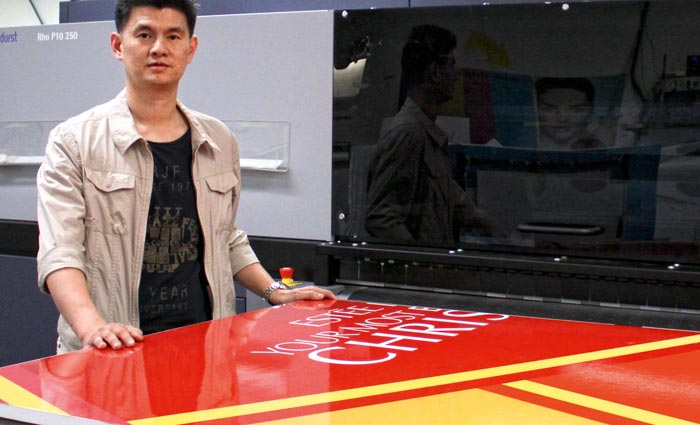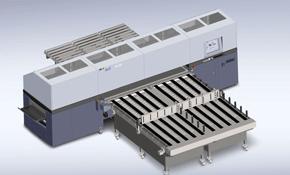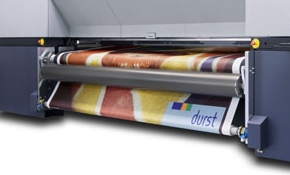
Describe your business
We started as a digital large-format printer. We now concentrate on four key growth areas: retail, exhibition and display, fabrics and re-board [a patented rigid paperboard].
What have you bought?
Asia-Pacific’s first Durst Rho P10 250.
What does it do?
The P10 is mainly targeted at fine-art reproduction. Our area of focus is mostly retail, and in that field there are clients that need very high-res printing. The P10 bridges the gap between technologies. Previously we had to print on photo paper and remount it on to the boards, whereas with this machine we can print directly on to the substrate. It’s a digital method but close to offset quality.
Why did you choose this product?
The speed and quality were important. Also, we can’t afford too much downtime.
Did you consider any other products?
We looked at three other printers, which we thought had similar quality and results – the Océ Arizona, Agfa and Vutek. The closest in terms of quality was the Océ. The other two were good in some ways, but lacked in other areas. We went with Durst because it’s currently much faster than the Océ, and also because of their level of service and we were familiar with their machines.
What features do you like most?
The speed and the print quality are the two main features. The other key factor is reliability. It all boils down to the level of service. Durst have represented us for 30 years or more. They’re willing to listen to the clients.
Is there anything you wish it had that it doesn’t?
There are two types of P10: the flatbed we purchased, and the roll-to-roll. We would like the P10 to be able to do roll-to-roll, but there’s already a machine for that.
How fast is it?
The P10 does 200m2 per hour, but we don’t run it at that speed. We usually do 70m2 per hour and sometimes up to 100m2 for some applications. At the moment, similar quality print in the market is only about 45m2, so we have a speed advantage. The machine can hit 200m2 per hour for one-pass work like banners, but for retail work, it generally takes three passes.
How reliable is it?
We’ve only had the P10 since the end of September, so it’s too early to say. But it’s built the same way as the Durst Rho 351R we have, which is about four years old. On that machine, we haven’t even changed a single head, which is very unusual. With other brands, we usually have to change one or two heads per year.
How easy is it to use?
It’s a printer with moving belts. We’ve used that type before, so it’s just a matter of getting used to the application. All the print can be cured, which makes it easier for the operator to prepare the job. They don’t have to wait for one job to finish before preparing the next.
Has it saved time and money?
Yes. Even though it was the most expensive of the four machines, it has led to greater productivity.
Has it won you any new business?
We now have a chance of winning work with some retail clients that wouldn’t consider us in the past. We’ve just landed one major client that previously did its printing on offset because it didn’t think digital had enough quality. This particular client has been able to save quite a bit by having us do the work digitally.
Were there any difficulties surrounding the install?
The installation went smoothly, because the machine had already been running at Visual Impact Image Expo for three days. The show finished on a Wednesday, it arrived on Thursday and was up and running on Friday.
How has the service been?
I would say Durst’s service is quite responsive. We don’t have to call service engineers often, because the machine is built strongly. If we need to call them, they usually come the same day.
Who is this product right for?
It’s suited for companies that are very conscious about their image and are willing to go the extra mile to get all the fine details right, even though it may be more expensive to print.
Would you buy another one?
We’re not thinking about it at the moment, but we might buy a roll-to-roll P10 at some point. In terms of capacity, our other Durst Rho 320R can still produce quite a fine resolution print.
Supplier’s response
Next Printing was looking for a UV printer with high resolution together with high production speeds to fill a requirement in the POP market. When Durst released the P10 at Drupa in May, Next could immediately see the advantage this printer offered. Having been a long-time Durst customer, they knew the quality, reliability and service support. The P10 250 was first demonstrated in Australia at Visual Impact Image Expo in September. During the show, Next took the opportunity to show clients the high quality of print now available from the Durst P10 printer.
Photo Electronic Services
Comment below to have your say on this story.
If you have a news story or tip-off, get in touch at editorial@sprinter.com.au.
Sign up to the Sprinter newsletter


